20770_Problem_solving_Year_5_Number_and_place_value_Using_units_of_measurement_3
Create successful ePaper yourself
Turn your PDF publications into a flip-book with our unique Google optimized e-Paper software.
TEACHER NOTES<br />
<strong>Problem</strong>-<strong>solving</strong><br />
To use logical reasoning <strong>and</strong> an ability to visualise a<br />
sequence <strong>of</strong> events so as to then use number patterns to<br />
solve problems<br />
Materials<br />
calculator<br />
Focus<br />
This page explores problems that involve a large amount<br />
<strong>of</strong> data that needs both computation <strong>and</strong> patterning to<br />
determine solutions.<br />
Discussion<br />
Page 61<br />
These problems can be used to examine the ‘analyseexplore-try’<br />
model <strong>of</strong> problem-<strong>solving</strong> that has evolved over<br />
the varied number, spatial, <strong>measurement</strong> situations posed<br />
in this book. This is discussed in detail in the introduction<br />
pages (xiv – xvii). In this problem the information needs to<br />
be carefully analysed to determine the distance <strong>of</strong> each<br />
shell from the starting line, the number <strong>of</strong> shells that are<br />
set out for the race <strong>and</strong> the distance to run to pick up<br />
<strong>and</strong> return each shell to the bucket, being that only one<br />
shell can be collected at a time. Some students may use<br />
counters to represent the race <strong>and</strong> see what is happening.<br />
<strong>Using</strong> a diagram is another way:<br />
Another way is to look for a pattern:<br />
4, 4 (1 + 2), 4 (1 + 2), 4 (1 + 2 + 3), 4 (1 + 2 + 3 + 4), …<br />
The total must be 4 x the sum <strong>of</strong> all the numbers 1–50.<br />
This result can be found by using a very famous method<br />
supposedly first shown by a mathematician named Gauss<br />
when he was only a young boy.<br />
Sum wanted is 1 + 2 + 3 + 4 + 5 … + 50.<br />
This sum is also 50 + 49 + 48 + … + 1.<br />
Twice the sum must be 50 x 51, so the sum is half <strong>of</strong> 50 x<br />
51. ([50 x 51 = 2500] ÷ 2 = 1275)<br />
The winner must run 4 x 1275 = 5100 m.<br />
This thinking now has to be applied in reverse to the<br />
second problem. Since Jeff picked up 42 shells, the<br />
distance he ran must be 4 x sum to 42 (i.e. 4 x half 42 x<br />
43), which is 3612 metres; Jeff ran 3 km 612 m.<br />
Possible difficulties<br />
• Not underst<strong>and</strong>ing the way in which the shells are<br />
distributed from the starting line<br />
• Only using the distances to the shells<br />
• Not attempting a solution because <strong>of</strong> the complexity<br />
<strong>of</strong> the steps or calculations<br />
Extension<br />
• Use smaller or larger number <strong>of</strong> shells for the race<br />
<strong>and</strong> vary the distance between shells.<br />
• Ask students to research the mathematician Karl<br />
Gauss <strong>and</strong> find out more about his famous solution to<br />
the sum <strong>of</strong> the first 50 numbers.<br />
When the problem is understood, a table that keeps track<br />
<strong>of</strong> the distances to each shell <strong>and</strong> the cumulative distance<br />
covered would enable an answer to be obtained, or even<br />
allow students to see a pattern in the results that can be<br />
applied to the whole situation.<br />
Shell number Distance run Total distance (metres)<br />
1 4 4<br />
2 8 4 + 8<br />
3 12 4 + 8 + 12<br />
4 16 4 + 8 + 12 + 16<br />
5 20 4 + 8 + 12 + 16 + 20<br />
This would suggest that adding all the numbers using a<br />
calculator which would give the correct answer <strong>of</strong> 5100 m<br />
or more than 5 km (which at first seems surprising).<br />
60<br />
<strong>Problem</strong>-<strong>solving</strong> in mathematics www.ricpublications.com.au R.I.C. Publications ®


















